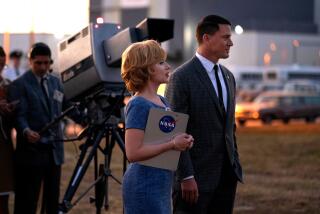Over the moon for the moon
- Share via
James May begins his new documentary, “James May on the Moon” (BBC America, 8 p.m. Tuesday), where he belongs: in a car, on the ground. He’s a host of “Top Gear,” the cheeky British automobile variety show, and on that show, he passes for unambitious, the lumbering turtle up against Jeremy Clarkson’s fox and Richard Hammond’s rabbit.
But May, it turns out, wants to go faster than any “Top Gear” segment could allow. A space enthusiast, he’s used his bully pulpit to film “James May on the Moon,” about the Apollo moon landings and his fascination with Earth’s satellite, where -- spoiler alert -- he does not in fact end up.
This extravagant hourlong program is actually three documentaries in one, leaving what must certainly be a tremendous amount of footage unused. Firstly, and most effectively, it’s a personal memoir about growing up under the spell of the early, renegade days of space travel. “A moment of global nervousness,” May says, quite neatly. May recalls his father waking him in the middle of the night to watch the Apollo 11 moon landing -- that flash of fascination stuck with him for years.
Like an overgrown child is how best to experience the second part of this show, which captures May’s three-day reality-show immersion into astronaut training. May is 46 -- “too old, too unfit and frankly too long-haired ever to know what it would mean to be an astronaut,” he says. Inside the huge centrifuge-like contraption that whips him around at a force of five Gs for 30 seconds, May looks pained, his face stretched into a mournful scowl. But when it stops, he picks up the narration still strapped into the chair, ever cheerful. He’s just as charming on G-Force One, the airplane that travels on parabolic paths to simulate, for quick bursts, the feeling of weightlessness. Seen through this lens, astronaut training is a kind of quirky camp, a few hastily thrown together feats of human endurance that might end up as challenges on “Survivor” or “The Amazing Race.”
Toward the end of “James May on the Moon,” as May views the Earth from a perch in a U-2 spy plane 70,000 feet in the air, it morphs into an educational program, a sort of poor man’s “Nova.” Stepping out of the plane after the trip, May begins his tweedy musings on The Meaning of Earth: “The Apollo astronauts saw it for what it really is -- nothing more than a dust mote left over from the Big Bang.”
Surely this is when the big questions will be addressed, about the importance of space travel, and the relationship of humans to other species, and of Earth to other planets and galaxies. But no: “James May on the Moon” is content to be an amusing trifle, a tour of one man’s whims full of jaw-dropping visuals and aw-shucks bromides. It has little of the verve of “Top Gear”: Without Clarkson and Hammond, May must be id, ego and superego all in one, and he’s not fully equipped for the task. (“James May on the Moon” is one of three space-related BBC-produced docs on BBC America this month. The others, “Apollo Wives” and “Being Neil Armstrong,” will air the next two Tuesdays.)
“What’s missing from current space operation,” May laments, is a “sense of swagger and theater.”
That’s exactly the attitude that “Top Gear” takes toward cars -- that they’re magnificent, multifaceted objects of study and play meant to be tinkered with and improved upon. But despite May’s evident fascination here, space travel never feels closer than arm’s length. He may be fluent in the numbers and the lingo -- or at least he knows how to compare the stages of a rocket to the gears of a car -- but there’s little vim or urgency here, just a man making memories about a memory few people remember anymore.
--
More to Read
Only good movies
Get the Indie Focus newsletter, Mark Olsen's weekly guide to the world of cinema.
You may occasionally receive promotional content from the Los Angeles Times.







